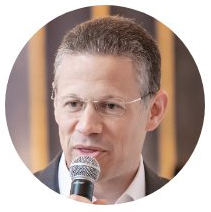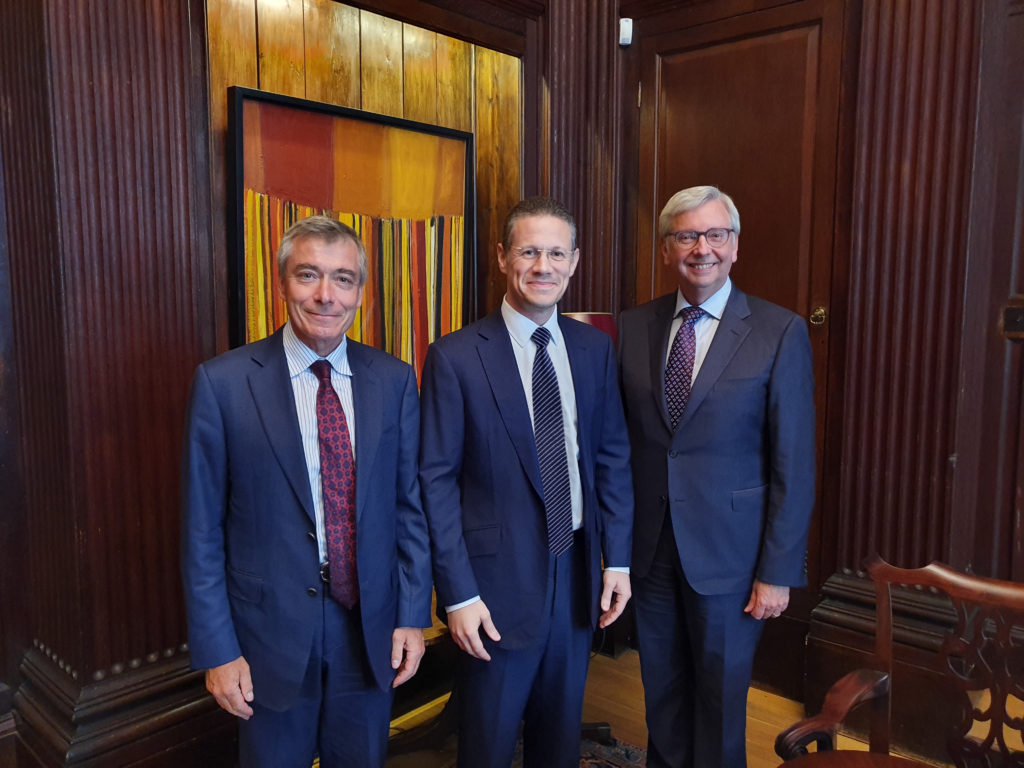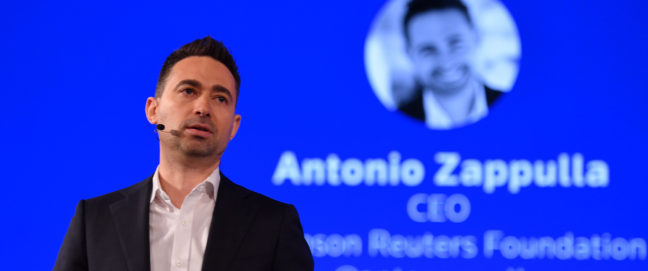Last year, the fastest-growing economies were all in emerging markets. This current wave of globalisation, which is pushing economic power both southward and eastward, will have a profound effect on philanthropy, and we should consider how to harness it strategically, says Emirati philanthropist and CEO of Crescent Enterprises Badr Jafar, who is also the founding patron of the newly established Centre for Strategic Philanthropy at the University of Cambridge Judge Business School.
 Speaking to Alliance’s digital editor, Elika Roohi, Jafar talked about the upcoming multi-billion intergenerational wealth transfer taking place across the emerging markets, the funding gap that needs to be bridged in order to meet the Sustainable Development Goals, addressing challenges like the climate emergency, and how the new Centre plans to contribute.
Speaking to Alliance’s digital editor, Elika Roohi, Jafar talked about the upcoming multi-billion intergenerational wealth transfer taking place across the emerging markets, the funding gap that needs to be bridged in order to meet the Sustainable Development Goals, addressing challenges like the climate emergency, and how the new Centre plans to contribute.
Why do you feel strategic philanthropy is an important area of study?
The world of philanthropy has been on a very interesting journey over the last decade. The various practices associated with giving continue to be disrupted. There are of course regulatory requirements in different markets around the flow of capital in general: Where is money starting from and where is it going? And how does transparency and accountability fit into that picture? Any in many jurisdictions there is intense focus on transparency and accountability when it comes to flows of business capital. But then with philanthropic capital, which is fundamentally private capital for public good, there are billions of dollars moving around between donors and beneficiaries every year that just aren’t subject to the same levels of rigour or discipline, not just in terms of where the money starts from and how it gets to the beneficiary, but also what actual impact it achieves.
The Centre is focused on high growth markets – the top 30 fastest growing economies last year all came from emerging markets, so we’re seeing this reallocation of economic power southwards and eastwards. I’m wondering what actionable knowledge you think is needed to enhance the impact of philanthropy in these regions?
It’s very tempting to apply a cookie cutter approach and to say, ‘Look at what’s worked brilliantly here,’ or ‘I’m sure there’s a lot that this region can learn from that region’. That may be applicable in some respects – there are certain universal principles that can be adopted from one place and accepted elsewhere, but there are also cultural nuances that need to be properly understood and taken into account. It’s not an East vs. West thing, or a developing vs. developed thing either. After all, there are certain philanthropic practices that are common place in London that you would rarely see in New York. Conversely, there are methods of giving in the US that would be considered illegal in the UK, such as political campaign contributions, etc. So, these nuances have to be appreciated, and cultural variances need to be respected. I think an important starting point really needs to be a proper understanding of how philanthropy is practiced in high-growth markets. These markets are broad – what happens in developing Asia, in the Philippines for example, would be very different from what’s happening in the UAE, which would be very different to what’s happening in Nigeria or Brazil.
There’s obviously a lot of work to do to properly understand this all, but that has to be the starting point. The Centre obviously has multiple tools in its toolkit to achieve its broader mandate and impact, and a very important one is research, hence its association with a well-established academic institution like Cambridge. We don’t want to take anything for granted, and there is a lot that we simply don’t know. I’m from the Middle East, born and raised, but there is still so much more I’d love to learn about people’s expectations here, practices and fears, and the sense of opportunity that exists around philanthropy in the region itself – unfortunately these conversations don’t happen enough.
Today, anywhere between 400 billion to a trillion dollars is dispersed in Islamic philanthropy every single year… That’s triple the combined annual global development and humanitarian aid budgets. But where is that money going? We unfortunately simply don’t know enough.
It took us a few years to try and get a philanthropy network of sorts launched here in the Gulf, and we eventually did that through a non-profit I founded about a decade ago called the Pearl Initiative, which is focused on corporate governance, transparency, and accountability in the Gulf region. A few years ago, we launched a specific programme for governance in philanthropy, in collaboration with the Gates Foundation, and that was what eventually led us to create a philanthropy circle to share best practice and discuss opportunities and risks around giving in the region. So, we’re only just starting to have these sorts of structured conversations, but that’s one way for us to figure out where the opportunities are, and also look to partner and collaborate with other circles or networks of philanthropy in other markets to learn from each other with a view to establishing best practice.

A new Centre for Strategic Philanthropy has been established at the University of Cambridge Judge Business School.
Of course, I’m asking this question as the editor at a publication with a global focus that’s based in the UK. Given the global focus of the Centre for Strategic Philanthropy’s work, why was the decision made to establish it at Cambridge?
The practical reason is that if you base a Centre of this nature in any one of the emerging markets that it is focused on, then it is likely to be overly associated with that particular market. The other thing is that the UK is a very well-established destination when it comes to regulatory frameworks. For example, the UK is the centre for Islamic finance. Why isn’t a Muslim majority country the centre for Islamic finance? Well, because the UK has very well-established capital markets, financial systems, banking sector, and a great regulatory environment.
But ultimately, I think Cambridge itself, with 800 years of history, has a long track record and a huge amount of trust associated with its brand. The University of Cambridge is also going through a journey itself from being UK-centric to being much more global as an institution. They appointed last year their first ever non-British Vice Chancellor, Professor Stephen Toope. If you talk to him and his colleagues, they’re very clear that one of the key future strengths of Cambridge lies in its ability to reach out and build bridges, not just expect everybody to come to Cambridge, because that’s not how the world works today.
Trillions of dollars will be passed on from one generation to the next over the course of the next decade – the figure for Asia alone is $2 trillion by 2030. What systems and structures do you think are needed to channel that wealth effectively, and how will the work of the Centre contribute?
Allow me to use just one example to illustrate the opportunity: Today, anywhere between 400 billion to a trillion dollars is dispersed in Islamic philanthropy every single year. This is between Zakat, which is compulsory alms giving – one of the five pillars of Islam – and Sadaqah, which is discretionary alms giving. On the one hand, that’s fantastic. That’s a huge amount of money. That’s triple the combined annual global development and humanitarian aid budgets. But where is that money going? We unfortunately simply don’t know enough about that. It’s an opportunity to address it, but it’s also a massive problem today. How does one go about ensuring that the money is being channelled in a safe way, through the right platforms, and to the intended ultimate beneficiaries?
Well, therein lies the opportunity. I think technology can play a huge role, but the Centre itself can also help identify and shine a light on some of the systems and mechanisms that are required to ensure that more philanthropic capital is generating its intended impact, and ideally, to generate a multiplier effect on that impact.
My personal take is that I’m hoping at least that [COVID-19 will] create a more urgent imperative for collaboration within the sector. A lot of great conversations take place, intellectual and others, but very little actual collaboration.
We’ve been working for a number of years, and in fact we’re just in beta testing mode now, on a non-profit digital platform to channel Islamic philanthropy to help fund credible development and humanitarian projects across the world. The platform itself is a charity registered in the UK, and we have entered strategic partnerships with reputable global institutions to help guide and nurture the platform in its formative years. It’s being launched precisely because we need to channel a lot more of that philanthropic capital in an open, transparent, impact-driven fashion. It’s a huge opportunity, and there’s also an urgency to see that happen in order to avoid unintended negative consequences of well-intentioned aid ending up in the wrong hands. Many wonder where many of these destructive non-state actors are getting their funding from. Imagine, tiny leakage from that huge pot ending up in the wrong hands can cause destruction on a global level. We’re talking a huge amount of money, so there’s an urgency to properly understand these flows of capital.
With the Sustainable Development Goals, there’s a $2.5 trillion annual funding gap to reach them by 2030. What needs to happen to channel the wealth that exists effectively?
A lot of people talk about the importance of raising more philanthropic capital, and I think the quantity aspect of the conversation is indeed important, because there’s always more that can be raised and tapped into, particularly in these markets where you have a lot of new emerging philanthropists. But beyond the quantity conversation, I think there’s not enough conversations happening about the quality aspect. Again, I give you the example of Islamic philanthropy. Forget the trillion, say the lower end of the estimate $400 billion a year – if that money was really channelled in the most optimal fashion to lift people out of poverty, then would you have one in three of the close to 2 billion Muslims living under the poverty line? It’s madness: $400 billion a year in alms-giving, yet one in three Muslims lives on less than two dollars a day. So I genuinely believe that philanthropic capital, applied strategically and with accountability, has a huge role to play alongside other pools of capital to help plug the gaps that exist in meeting our global development and humanitarian goals.

Left to right: Professor Christoph Loch, Director of the Cambridge Judge Business School; Badr Jafar, Founding Patron of the Centre for Strategic Philanthropy; and Professor Stephen Toope, Vice Chancellor of the University of Cambridge signing the agreement for the Centre for Strategic Philanthropy on 25 September 2019.
With coronavirus, I think it will change many things about our world including the economic models of philanthropy. How do you think it will affect economic models, and what do you hope the Centre’s research on the subject will be able to contribute?
I can only speak to my own views on this, but I think the Centre must help us all to better understand this from the perspective of others, especially in some of the world’s fastest growing regions. In fact, that is one of its first research projects. The Centre’s first [project] is focused on understanding what exists out there in terms of research and analysis around philanthropy in and from the emerging markets – creating a repository of sorts. It would be a waste of money and time to reinvent the wheel, so let’s really find out and understand what’s already out there, and create a database of research that exists on the emerging markets for all to see, which will in turn also help to identify the gaps in research and data.
The second research project, which is linked and related, is a needs assessment. This entails going to philanthropists and aspiring philanthropists, in addition to beneficiary organisations, and asking what they would like to know and understand better. Where do they feel there is a dearth of data, information, or a lack of understanding of certain aspects of philanthropic practice in their own geographies or areas of interest? What would they like to see in a research agenda for a Centre which is dedicated to these markets? Those are the two first big pieces of research that the Centre is in the process of conducting, and then of course Covid came along, and presented an opportunity to explore exactly the question you asked: What does the ecosystem of philanthropy in these markets feel about changing patterns and habits as a direct result of the COVID-19 pandemic? So this is another important piece of research that is currently underway.
Fundamentally, whatever cause you’re pursuing, if you’re really trying to identify how you can get involved and collaborate with others interested in the same, you need good no-nonsense data.
My personal take is that I’m hoping at least that it’ll create a more urgent imperative for collaboration within the sector. A lot of great conversations take place, intellectual and others, but very little actual collaboration. There are many different forms of collaboration obviously, but what Covid has demonstrated, not just within philanthropy but elsewhere, is that all of our global challenges require a collaborative effort. I’m hoping that one of the shifts will be more pooling of philanthropic capital, more collaborative ventures between foundations and family offices that are also seeking to generate positive social and environmental impact with their capital.
Although this doesn’t happen enough globally, I think it happens even less in these markets. I can’t think of an example of true collaborative philanthropy in the Middle East or North Africa, for example, where two philanthropists have gotten together and said, ‘Let’s put our money together and create this’. You have many donors donating to existing foundations, of course. With the Pearl Initiative which is not a foundation, but a non-profit, we have great partnerships where businesses and individuals donate to help scale its cause. But I’m talking about true donor-donor partnership. I think this is a huge opportunity, and I’m hoping that is a key cultural shift, fingers crossed, that will come out of Covid, specifically within philanthropy.

Follow Alliance’s ClimatePhilanthropy2030 project for reporting on philanthropy’s response to the climate crisis.
Another area where people are calling for collaboration would be the climate emergency, and one of the things that some foundations are choosing to do – in addition to funding climate action – is to divest their endowments from fossil fuels and put the funds into green investments. I’m wondering, because you’re someone whose business is in petroleum, what you think of this movement? Do you think philanthropy can seek to address the climate emergency if its money is invested in the sectors it wants to eventually move away from them?
People ultimately need to put their money where they feel they will get the best bang for their buck, towards causes that resonate with them, and where they feel their philanthropic capital will achieve the greatest impact. Within the climate space, I think there is definitely an important role for philanthropic capital. The climate space specifically is a great example where you can have impactful blended capital. There are certain risks associated with all new technologies, including of course renewable technologies, where sometimes private business capital might not be the first to rush in to test new technologies, because of fear of not being able to generate the expected returns for their shareholders. I think that’s where philanthropic capital can come in and take some of the edge off that sort of risk.
The climate conversation is an example of where there is a lot of confusion. It’s highly politicised, and for someone who is thinking, ‘I want to help the climate, I want to help save this world from environmental damage, what can I do with my money?’, it’s actually very confusing to navigate. Cutting through a lot of the noise is very important, but ultimately the role of technology is central, because as we move and transition from a more traditional fossil fuels world to a renewable world, the role of technology is going to be essential to make sure that we achieve the three ‘A’s’ associated with any successful energy transition, and that’s affordability, accessibility and acceptability. You need all three to have scalable solutions. On the affordability and accessibility side, that’s where the role of technology can play a very important role, and this is where I think philanthropic capital, perhaps through venture philanthropy, can come in to help accelerate new discovery and even deployment. This obviously doesn’t just apply with environmental causes – we’re seeing some successes with venture philanthropy in the healthcare space with new drug discovery and cures for rare diseases, for example.
Fundamentally, whatever cause you’re pursuing, if you’re really trying to identify how you can get involved and collaborate with others interested in the same, you need good no-nonsense data. When you want to make evidence-based assessments, this is where I think an academic centre in a very well-established, independent, and reputable institution like Cambridge and now its new Centre for Strategic Philanthropy can definitely help donors or prospective donors cut through the noise and the politics and get to the crux of the issues and their solutions.
In this move towards strategic philanthropy, how important do you think it is to support professional associations and networks, so philanthropy infrastructure, and philanthropy support organisations? And connected to that, how important do you think philanthropy focused media like Alliance is to this endeavour of philanthropy?
Both hugely important. When I was asked if I would join the Giving Pledge, it took me a while to sign up to it, because the mere act of giving away money isn’t what generates results per se. Identifying personally with what I wanted to really try and achieve in terms of impact and results with my philanthropy, beyond just giving away money, was essential. So, I had to go on that very personal journey, and what became very clear as an opportunity was the lack of infrastructure around giving – particularly in some of these rapidly growing markets, but also globally – is something that’s in need of a lot more attention. In my Giving Pledge letter, I made it clear that’s where my focus is going to be. It’s going to be philanthropic engagement around building strong infrastructure in the sector, because that in itself will help to generate a multiplier effect on everyone’s philanthropy. So, with the work that I’m doing with the likes of the Pearl initiative and with the work of the CSP, it’s all based around that principle and objective. I think that’s essential. And it’s very exciting when you see these networks work, because in a very short space of time you see a much more, not just professionalised, but also invigorated community and ecosystem, just by bringing people together in the right way. It needs to be structured, but not overly so, because you also need to allow flexibility in the system, and that is very much what I’m focused on with my own philanthropy.
I think an important starting point really needs to be a proper understanding of how philanthropy is practiced in high-growth markets. These markets are broad – what happens in developing Asia, in the Philippines for example, would be very different from what’s happening in the UAE, which would be very different to what’s happening in Nigeria or Brazil.
And to your second point about philanthropy-focused media – again, it’s absolutely essential. Take the Middle East for example, where things probably haven’t gone fast enough in this space. There is a huge opportunity for well-informed, independent, and no-nonsense journalism around what is happening in philanthropy, delivered by people on the ground who are cultivating relationships and building trust. Cutting through the headlines is also important, because the culture in a lot of markets is to just take your press release and go off that, but there’s always much more behind the headlines that you need to delve into to understand what is happening and what isn’t that perhaps needs to be. This of course is the ABC of good journalism, but I’d love to see more of that within this sector and in these markets. I see that as part of building the infrastructure, because if you don’t have good information sharing and news distribution around this topic, then you’ll be operating in the dark a lot of the time.
 Badr Jafar joined Alliance and the Centre for Strategic Philanthropy on 1 July for a webinar to explore philanthropy’s role in contributing to social impact. Watch the recording of that webinar here.
Badr Jafar joined Alliance and the Centre for Strategic Philanthropy on 1 July for a webinar to explore philanthropy’s role in contributing to social impact. Watch the recording of that webinar here.






Comments (1)
I think this is awesome. We need more initiatives and studies on philanthropy within emerging markets and more ways to bring people from these countries together for deep discussions around philanthropy and the opportunities to scale impact. Congratulations to University of Cambridge for taking the lead on this. Happy 2021 to all.